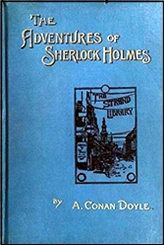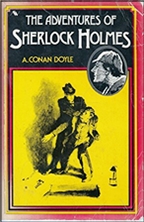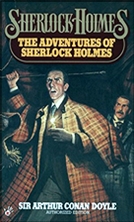Sat 18 Nov 2023
A 1001 Midnights Review: ARTHUR CONAN DOYLE – The Adventures of Sherlock Holmes.
Posted by Steve under 1001 Midnights , Reviews[3] Comments
by Edward D. Hoch

ARTHUR CONAN DOYLE – The Adventures of Sherlock Holmes. George Newnes Ltd., UK, 14 October 1892. Harper Brothers, US, hardcover, 15 October 1892. Stories previously published in twelve consecutive monthly issues of The Strand Magazine from July 1891 to June 1892. Collection reprinted numerous times. Stories adapted to radio, TV and the movies even more countless times.
The most famous book of short detective stories, and one of the best, remains this collection of the first twelve short stories about Arthur Conan Doyle’s immortal sleuth Sherlock Holmes. It is doubtful that the two earlier novels about Holmes would be remembered as more than curiosities today had it not been for the short stories that followed.
Judged strictly as a writer of detective stories, Doyle rarely played fair with the reader: In many of the stories, key facts are withheld and we have no opportunity to match Holmes’s brilliant feats of deduction. But it is not the plots so much as the characters of Holmes and Dr. Watson that have kept the stories alive for nearly a century. Doyle hit upon the perfect way to popularize the formula with which Poe and others had experimented, and his detective remains justly popular.

As many readers, both children and adults, have discovered to their pleasure, the stories in this first collection fully justify the book’s enduring popularity. All twelve are worthy of note, beginning with “A Scandal in Bohemia,” the least typical story in the Holmes canon. In it we meet Irene Adler and accompany Holmes on a delicate mission.
It was the second story in the book, “The Red-Headed League,” that really set the tone for those that followed. Here we have the client calling upon Holmes, the brilliant deductions by Holmes regarding the man’s background, the statement of the problem, the investigation by Holmes, and the solution. It was a pattern that rarely varied but almost always entertained the reader.
In “The Red-Headed League,” a critical and popular favorite among the Holmes stories, a man is hired because of his red hair to copy articles from the encyclopedia every day in a small office. Holmes discovers the real motive for this odd undertaking.

The crime in “The Five Orange Pips” has its roots in the activities of the Ku Klux Klan, and “The Man with the Twisted Lip” takes us inside a London opium den, showing Holmes as a master of disguise. “The Blue Carbuncle,” one of literature’s great Christmas stories, is about a missing jewel. “The Speckled Band,” about a woman frightened to death in a locked room, is a story almost everyone knows. and is probably the most popular Sherlock Holmes tale of all. “The Copper Beeches” is about a young woman hired to carry out an odd set of instructions at a country home.
Also in the volume are “A Case of Identity,” “The Bascombe Valley Mystery,” “The Engineer’s Thumb,” “The Noble Bachelor,” and “The Beryl Coronet” all typical of the cases from Holmes’ s most rewarding period.
———
Reprinted with permission from 1001 Midnights, edited by Bill Pronzini & Marcia Muller and published by The Battered Silicon Dispatch Box, 2007. Copyright © 1986, 2007 by the Pronzini-Muller Family Trust.
November 18th, 2023 at 10:36 pm
What was it Chandler said, a half dozen of the best lines in the genre? Julian Symons pointed out that in addition to the characters of Holmes and Watson the stories are adventure stories retold as puzzles with people and plots from the far corners of the world finding themselves on Holmes and Watson’s Baker Street doorstep.
Doyle’s style is surprisingly modern compared to his contemporaries in the STRAND and he is a much better writer than he is given credit for. Then as Hoch mentions the subject matter ranges from such modern topics as racism, domestic abuse, organized crime, and adultery. The stories are often simple, but Doyle tells them in such a way and reveals the truth through Holmes reconstruction of the evidence creating mystery and suspense from often fairly simple things like a dog not barking.
November 18th, 2023 at 11:51 pm
One thing that Ed Hoch said in this review that I hadn’t thought about before was this sentence:
“As many readers, both children and adults, have discovered to their pleasure, the stories in this first collection fully justify the book’s enduring popularity.”
He’s right. Children can read the Holmes stories and enjoy them as well as adults. They were always showing up in what were collections of kids’ mystery stories when I was one, a kid, that is.
Maybe I’m not the best example, since it’s been a long time since I was a kid, and I imagine things are different today, but I read The Redheaded League when I was ten, and I was spellbound.
Absolutely wonderful!
November 19th, 2023 at 8:34 pm
Robert Louis Stevenson in a letter to Doyle complained that the Hawaiian Islanders preferred Doyle’s Holmes stories to his own even though they had no idea what a Hansom Cab was or a city like London or moors or any of the trappings of the stories.
The Holmes stories are remarkably simple on the surface, but critics have been writing about them for well over a century seeking the influences and models for the individuals in the story.
As with James Bond the stories featured many barely disguised characters and celebrities from the Prince of Wales to the future Tzarina of Russia, the explorer Richard Burton, criminal masterminds Adam Worth and Charles Peace, Lola Montez and Lily Langtry, and more.